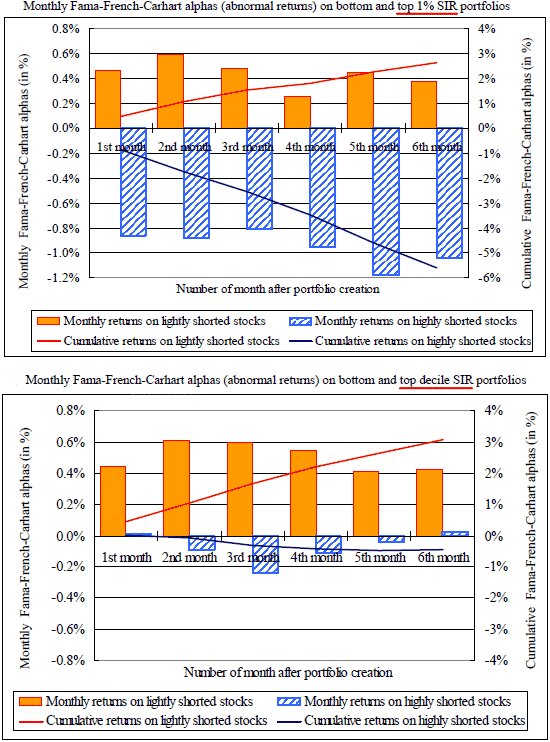The conventional wisdom is that short sellers are on average more informed than other traders, and high levels of short interest in a stock indicate poor future returns. Is the converse true? Do short sellers stay away from good stocks? In the May 2009 version of their paper entitled “The Good News in Short Interest”, Ekkehart Boehmer, Zsuzsa Huszar and Bradford Jordan investigate whether the absence of short selling is informative about future returns. They base their investigation on three lightly (heavily) shorted portfolios that include stocks from the 1st, 5th and 10th (90th, 95th and 99th) percentiles of monthly short interest ratios (SIR), along with three related long-short portfolios. Using monthly short interest, returns and firm characteristics for NYSE, AMEX, and NASDAQ stocks from 1988 to 2005 (930,109 stock-month observations), they conclude that:
- The percentage of stocks with short interest below 0.1% declined from over 52% to about 15% over the sample period. Large capitalization stocks are less likely to have low short interest.
- Heavily traded stocks with low short interest generate statistically and economically significant positive abnormal future returns, suggesting that positive (and publicly available) information associated with low short interest is only slowly incorporated into price. These positive returns are often larger (in absolute value) than the negative returns observed for heavily shorted stocks.
- An equal-weighted portfolio of 1% (99%) SIR stocks, rebalanced monthly, produces a raw average monthly return of 2.1% (-0.1%). The difference is smaller, but still material, for value-weighted portfolios.
- On a four-factor Fama-French-Carhart risk-adjusted basis (filtering out market, size, value and momentum factors), average monthly abnormal returns are 1.3% to 1.4% (around 0.5%) for the three lightly shorted portfolios with equal (value) weighting. Regardless of weighting scheme, these portfolios have low-risk market betas of about 0.60, resembling small capitalization value stocks.
- On a four-factor Fama-French-Carhart risk-adjusted basis, average monthly abnormal returns range from -1.2% per month for the 99% SIR equal-weighted portfolio to -0.4% for the 90% SIR portfolio. Value weighting diminishes the effect, but the 99% SIR portfolio consistently underperforms. Regardless of weighting scheme, heavily shorted portfolios resemble small capitalization growth stocks.
- The most interesting result is the return on a SIR 1%-99% long-short portfolio, which generates a large and highly significant abnormal return with a substantial negative market beta for either weighting scheme. This negative beta is stable over time.
- Abnormal positive future returns to lightly shorted stocks are robust to subperiods, the exact timing of portfolio formation, the risk-adjustment procedure, listing exchange and the inclusion/exclusion of recent new listings or the 1998-2000 period. In contrast, abnormal negative future returns to heavily shorted stocks are transient.
The following charts, taken from the paper, compare abnormal (four-factor) monthly returns for value-weighted portfolios of high and low SIR stock portfolios over the first six months after portfolio formation across the entire sample period. The top chart focuses on on the extreme 1% and 99% SIR portfolios. The bottom chart addresses the less extreme 10% and 90% SIR portfolios. The charts show that:
- Abnormal returns, when they exist, persist for at least six months after measurement of short interest.
- For extreme SIRs, abnormal returns on heavily shorted stocks are large relative to those for the lightly shorted stocks (but the heavily shorted portfolios here are small compared to the lightly shorted portfolios).
- Large abnormal negative (positive) returns on heavily (lightly) shorted stocks are (not) limited to the extreme first percentile. In other words, overvaluation of heavily shorted stocks is concentrated in very few of the most shorted stocks, while undervaluation of lightly shorted stocks encompasses a range of short interest ratios.

In summary, evidence indicates that short sellers are on average able to identify both overvalued and undervalued stocks. Investors/traders may be able to exploit the economically large positive future returns of lightly shorted stocks with simple long-only strategies.